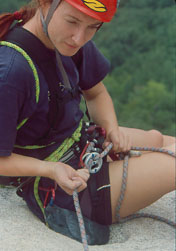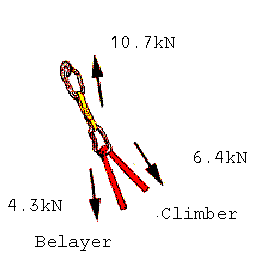
Many factors come together to determine the amount of force a falling climber will put on a belay anchor. The major factors are; the amount of energy the rope can absorb, the severity of the fall, the weight of the climber, and the friction of the rope running through a karabiner.
Let's take a look at the physics behind the amount of force a fallling climber can put on a belay anchor.
Given:
mass (avg. climber)* = 80kg
y (fall factor) = 2
M (rope modulus) = 9.81kN
g = 9.8 m/s2
Rope Modulus: Takes into consideration the static elongation of rope and gives a value for rope stiffness.
M = E * A
E = Young's Modulus
A = surface area of rope if were cut


Impact Force: Force on the climber.
Fimpact = mg [1+(sqrt 1+ 2yM/mg)]
= 6.4kN
The anchor has to withstand a force nearly twice the impact force. It holds the falling climber on one side, and on the other the force of the belayer holding the fall in the opposite direction (force is reduced by 1/3 because of rope friction on the karabiner).
I estimate that a normal size climber taking the most severe fall can generate upwards of 10.7kN of force on a belay anchor.